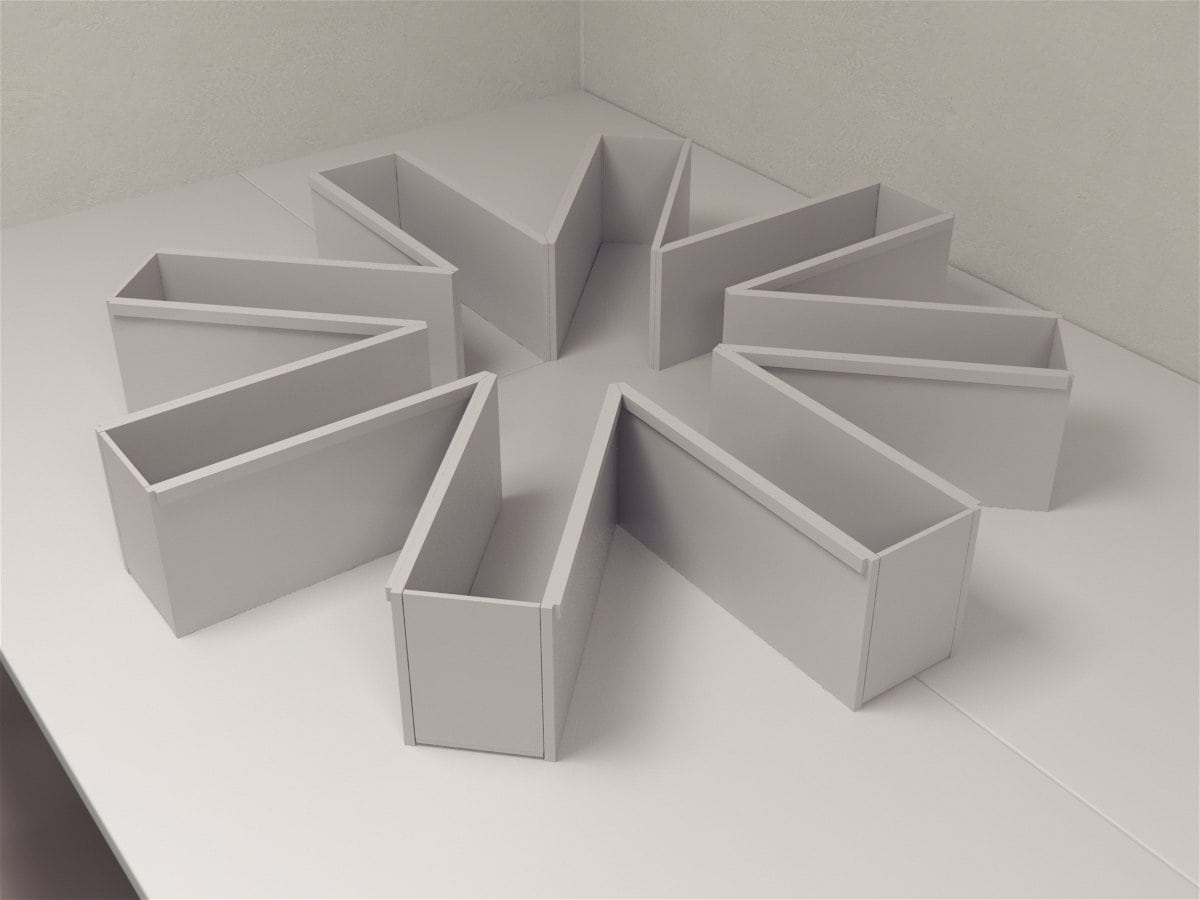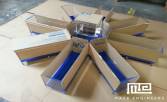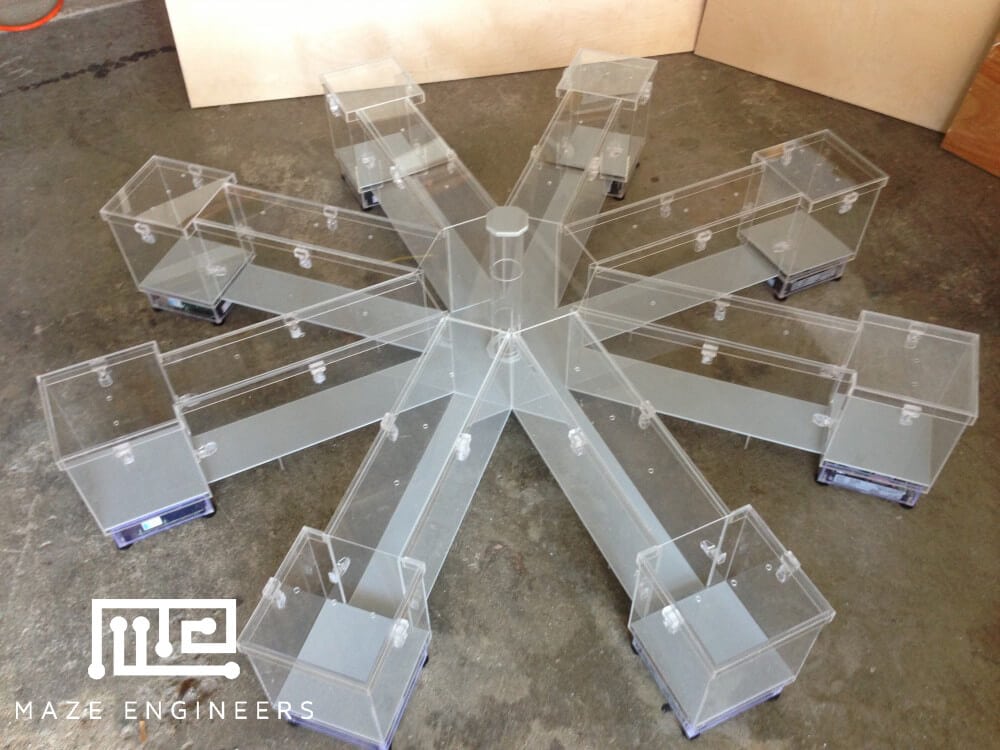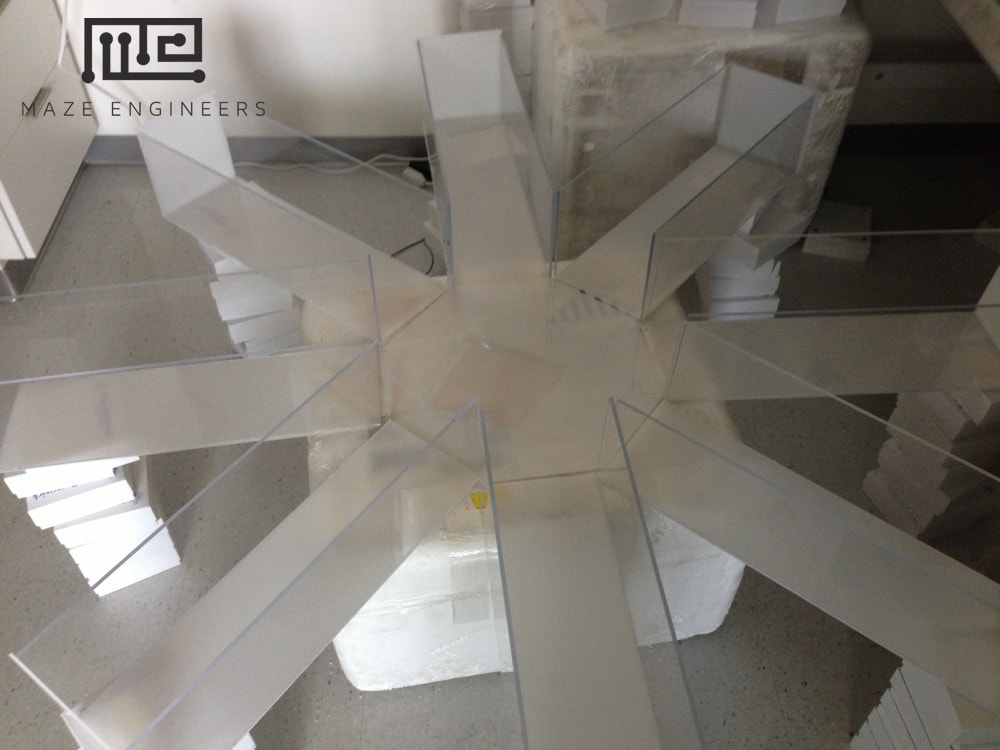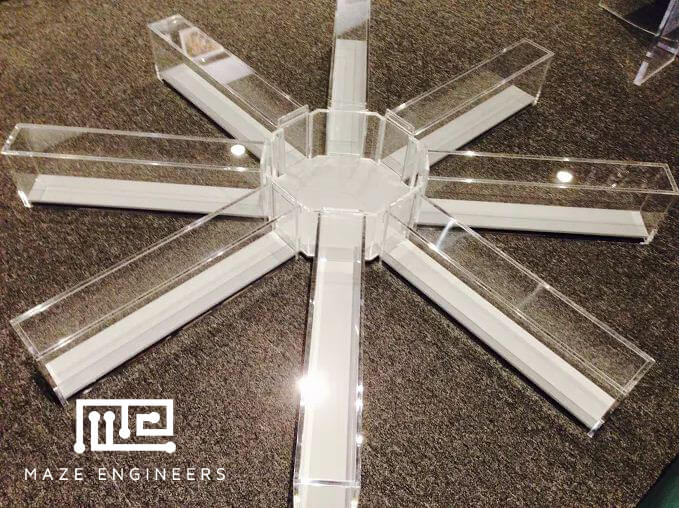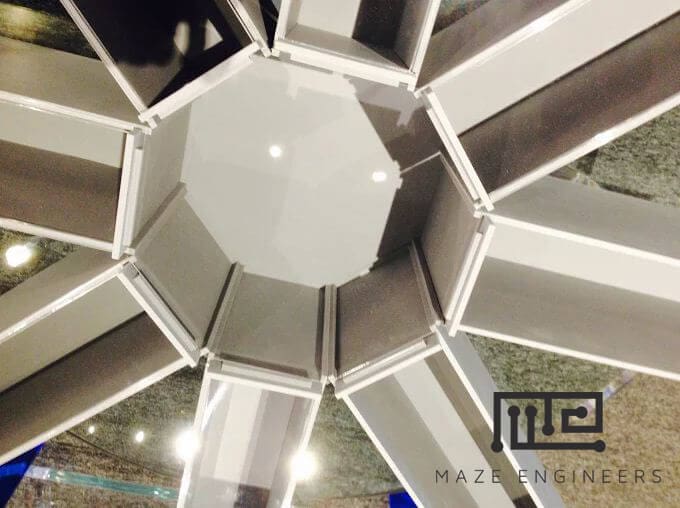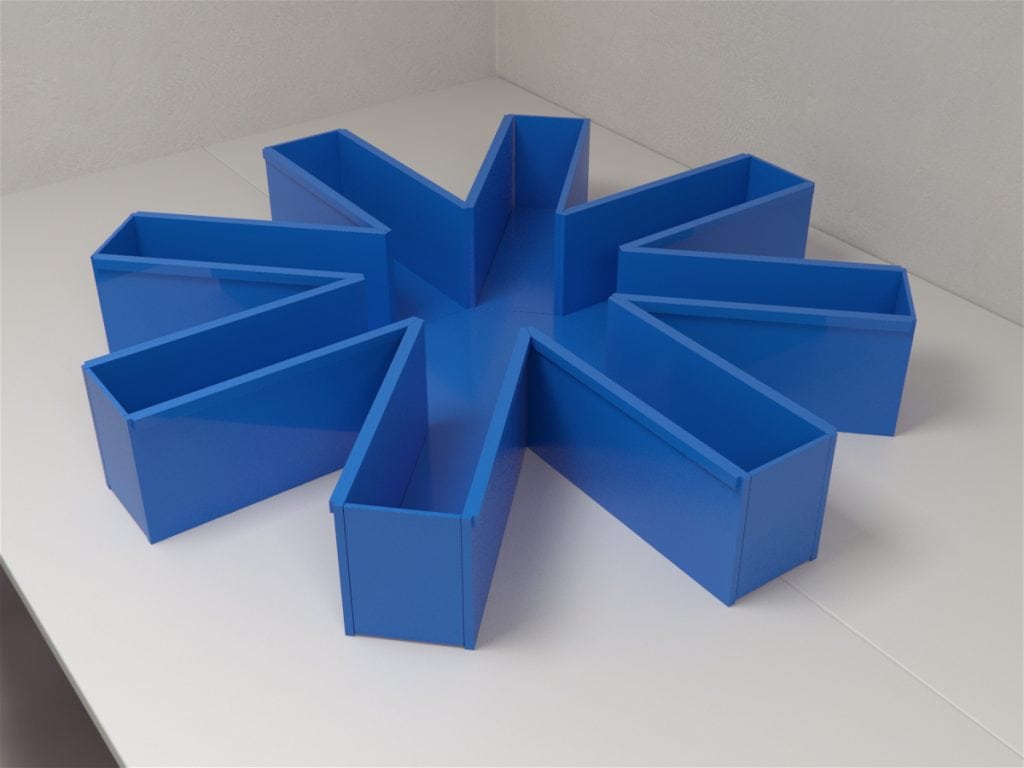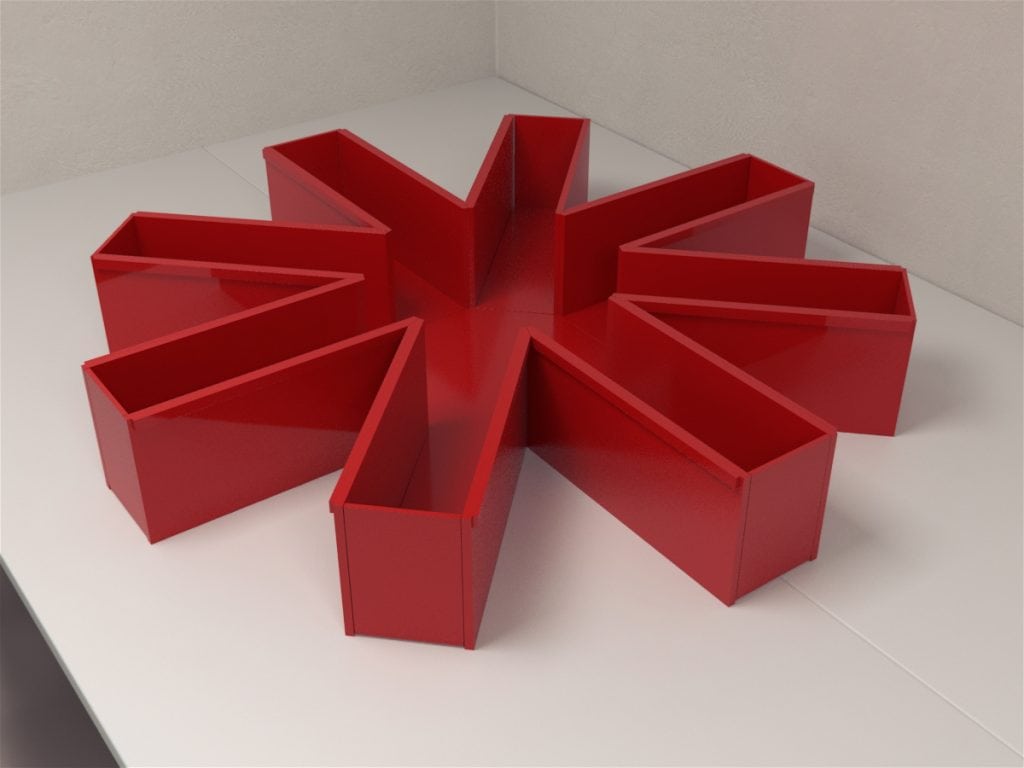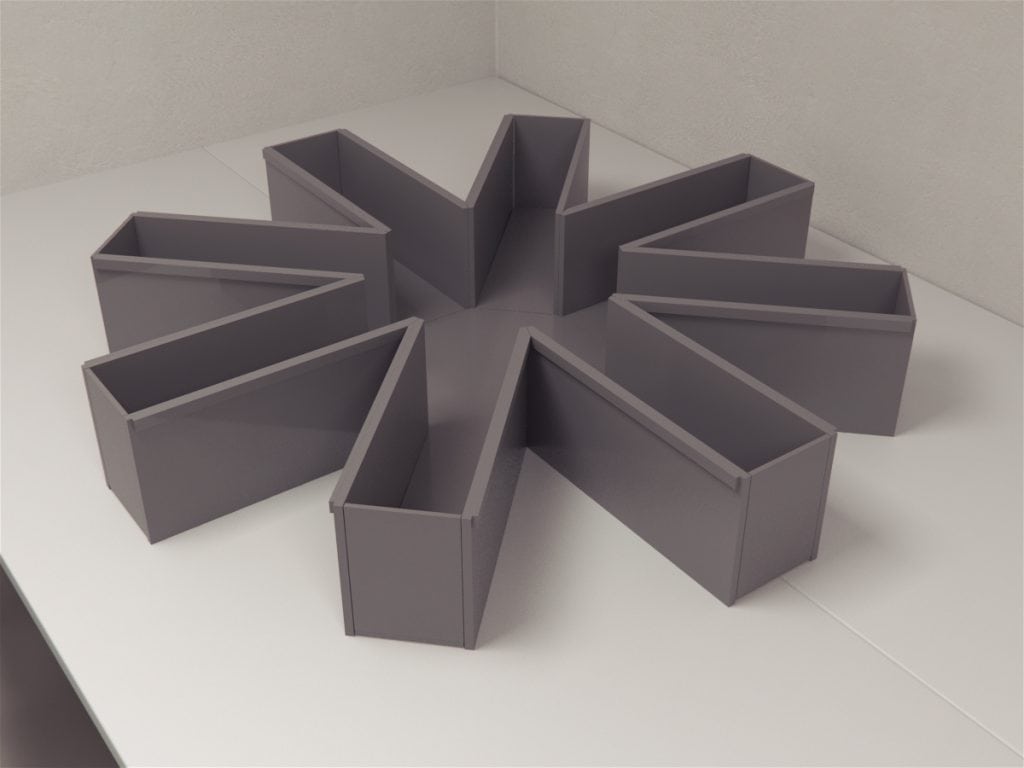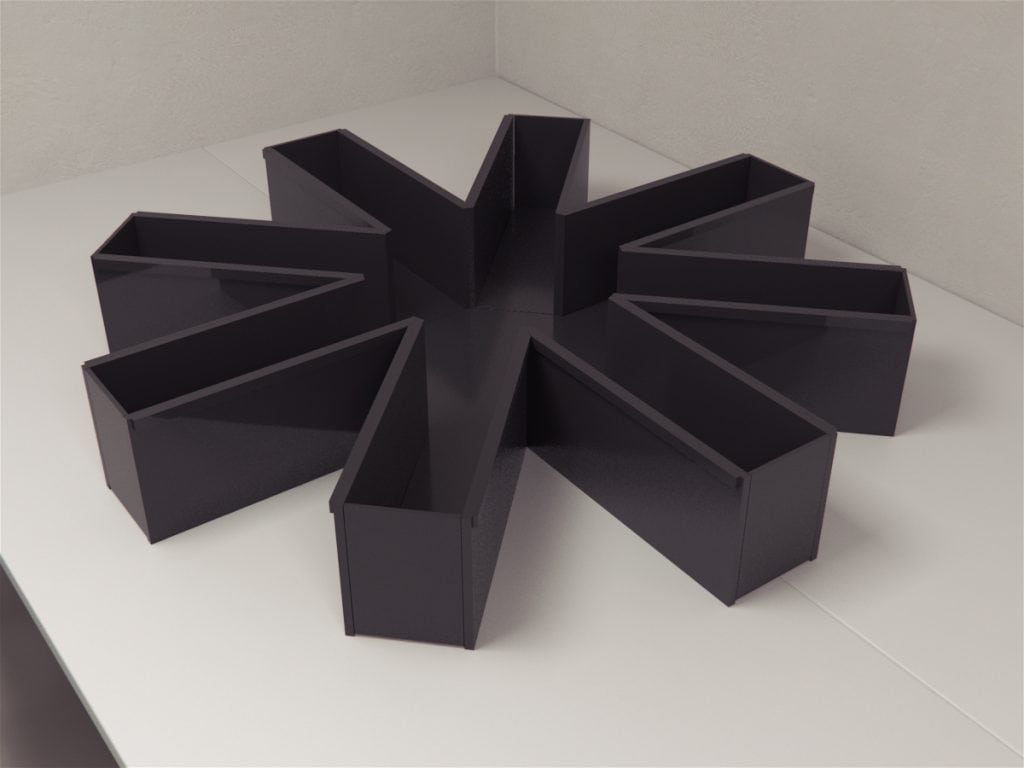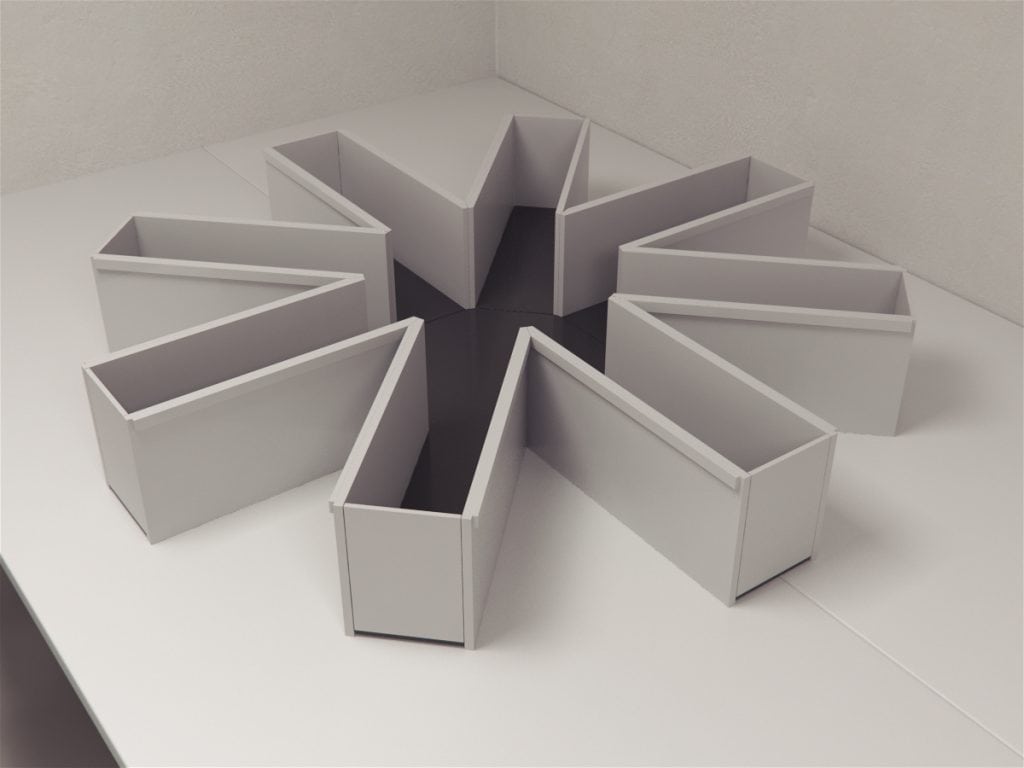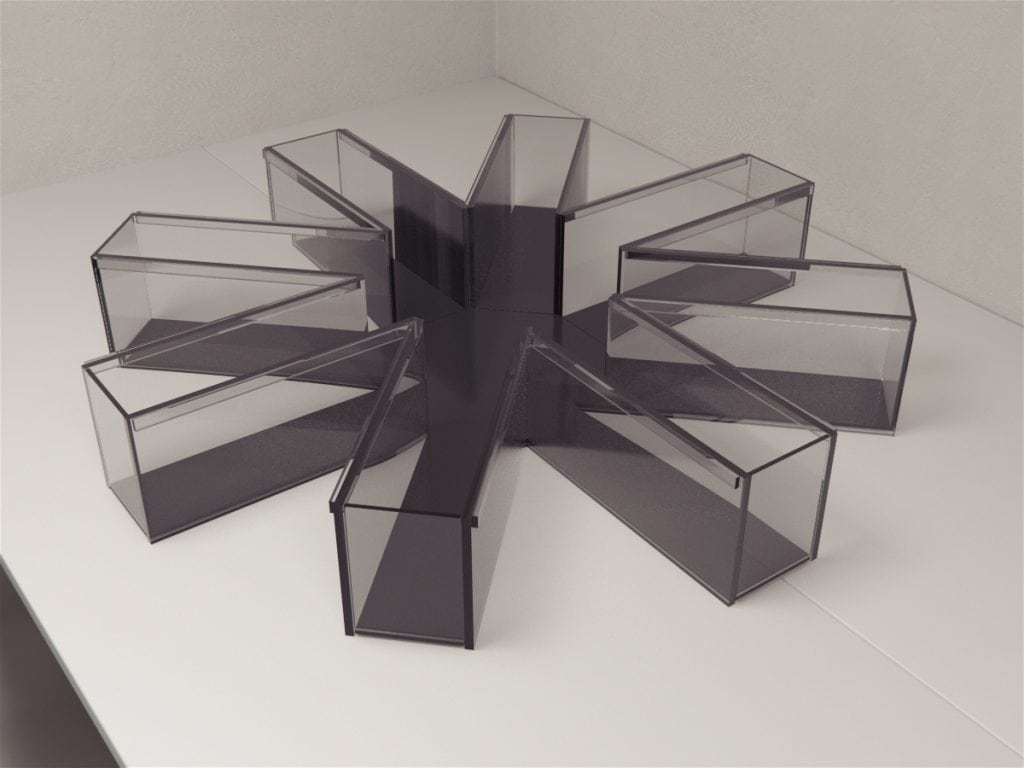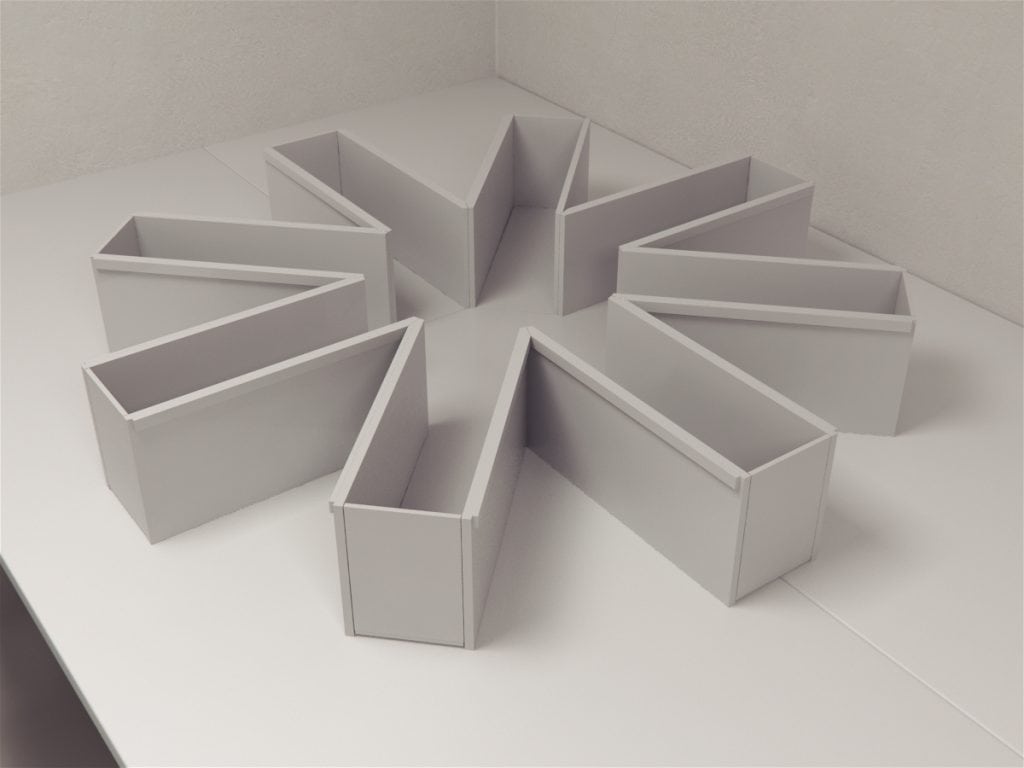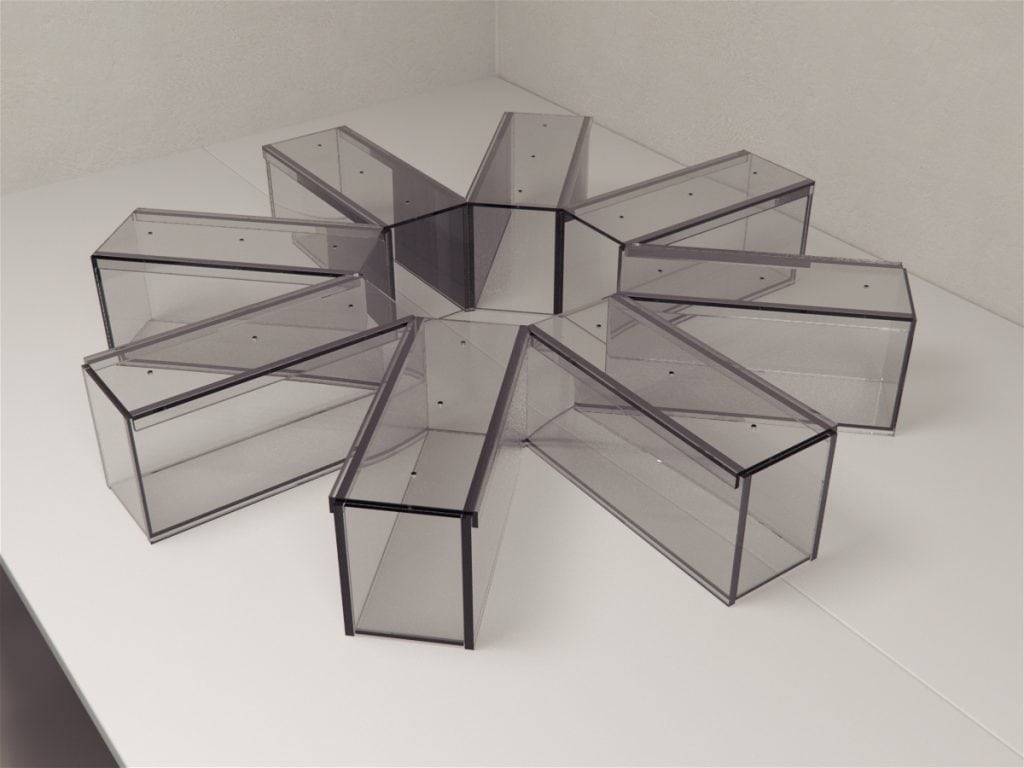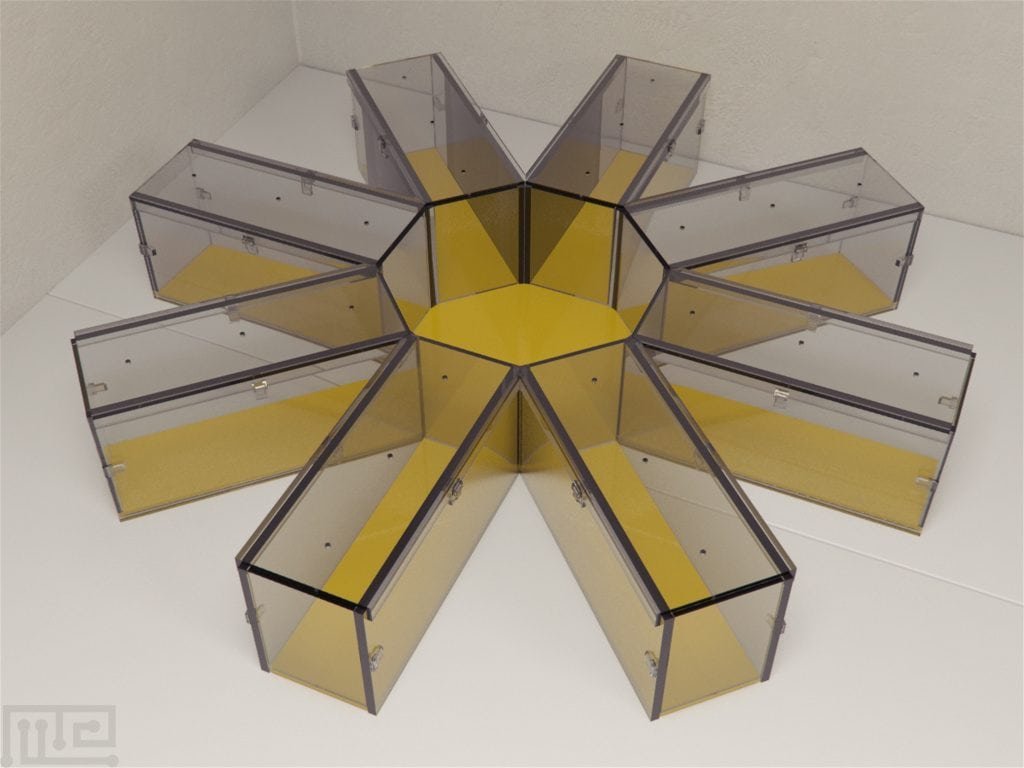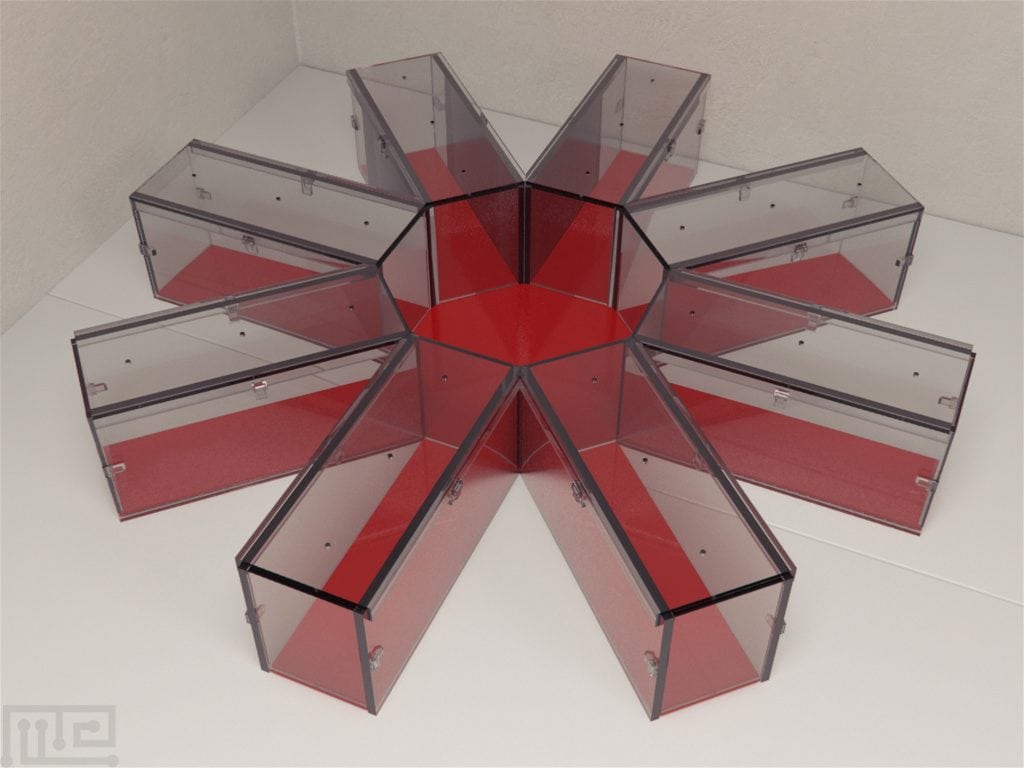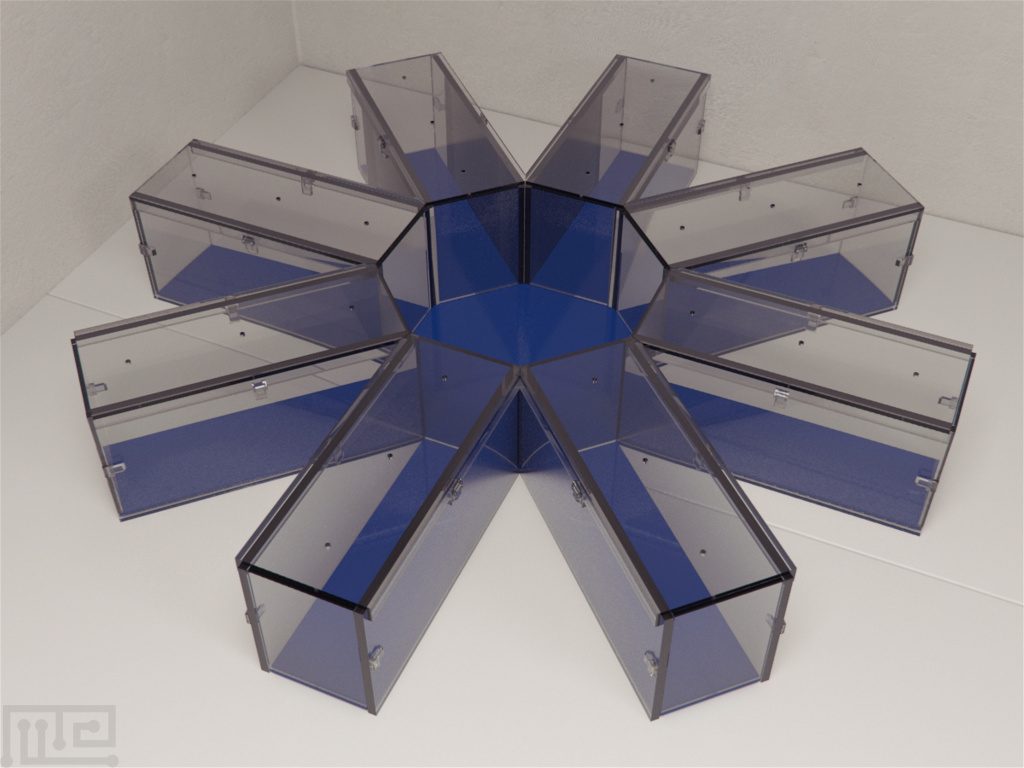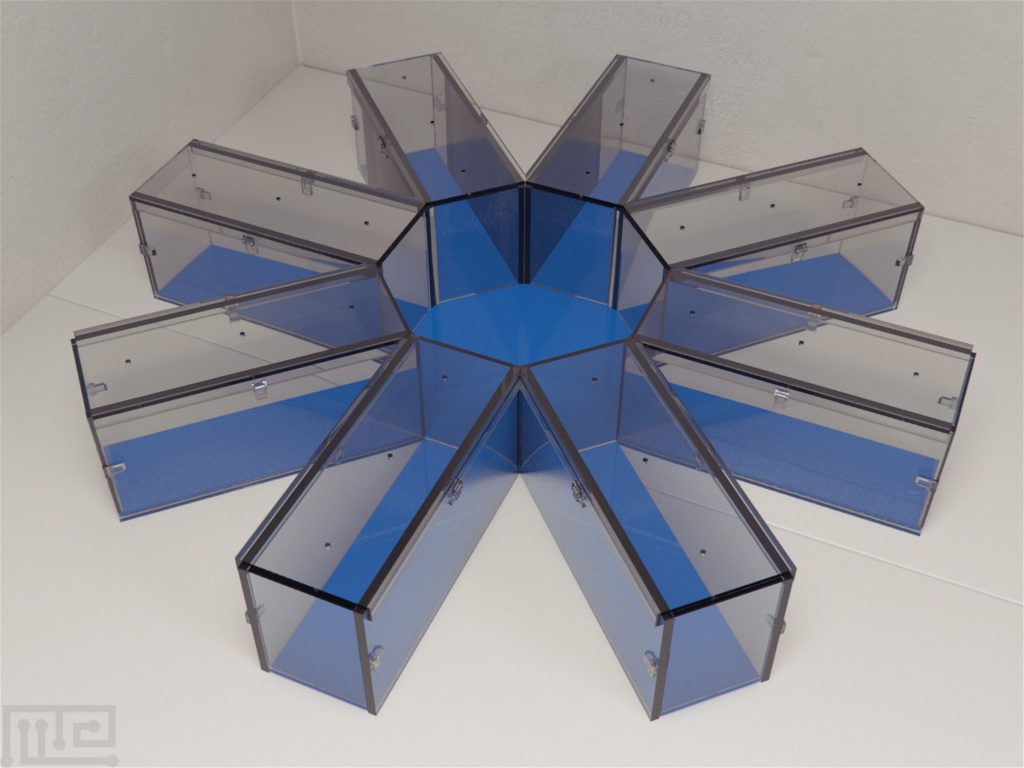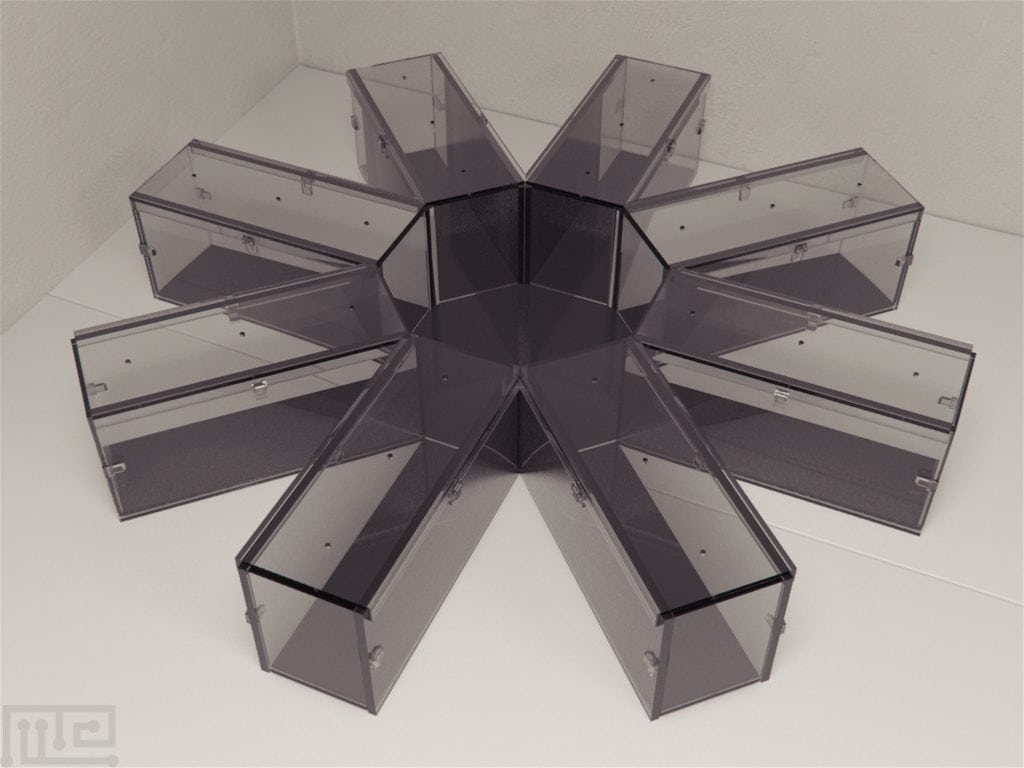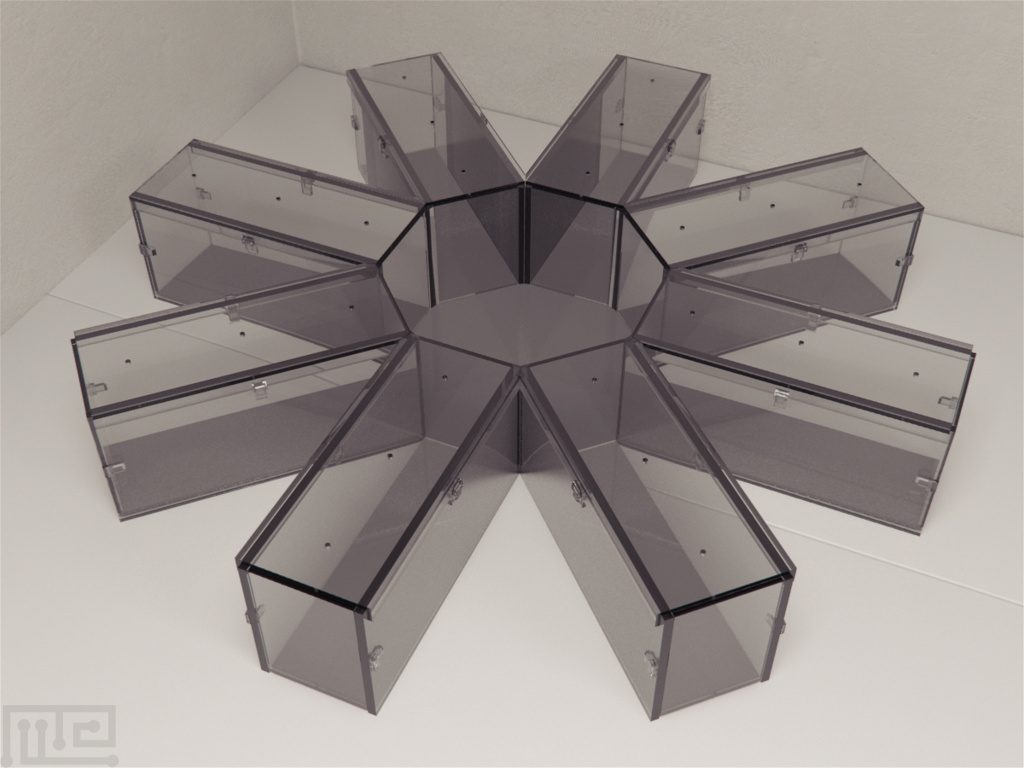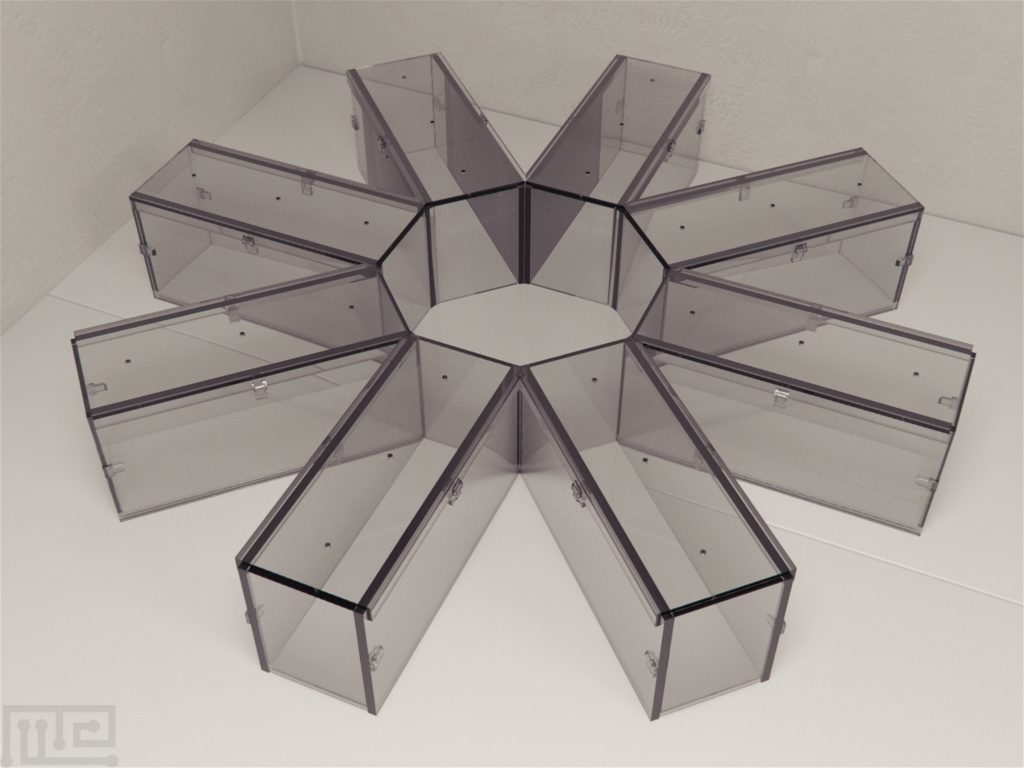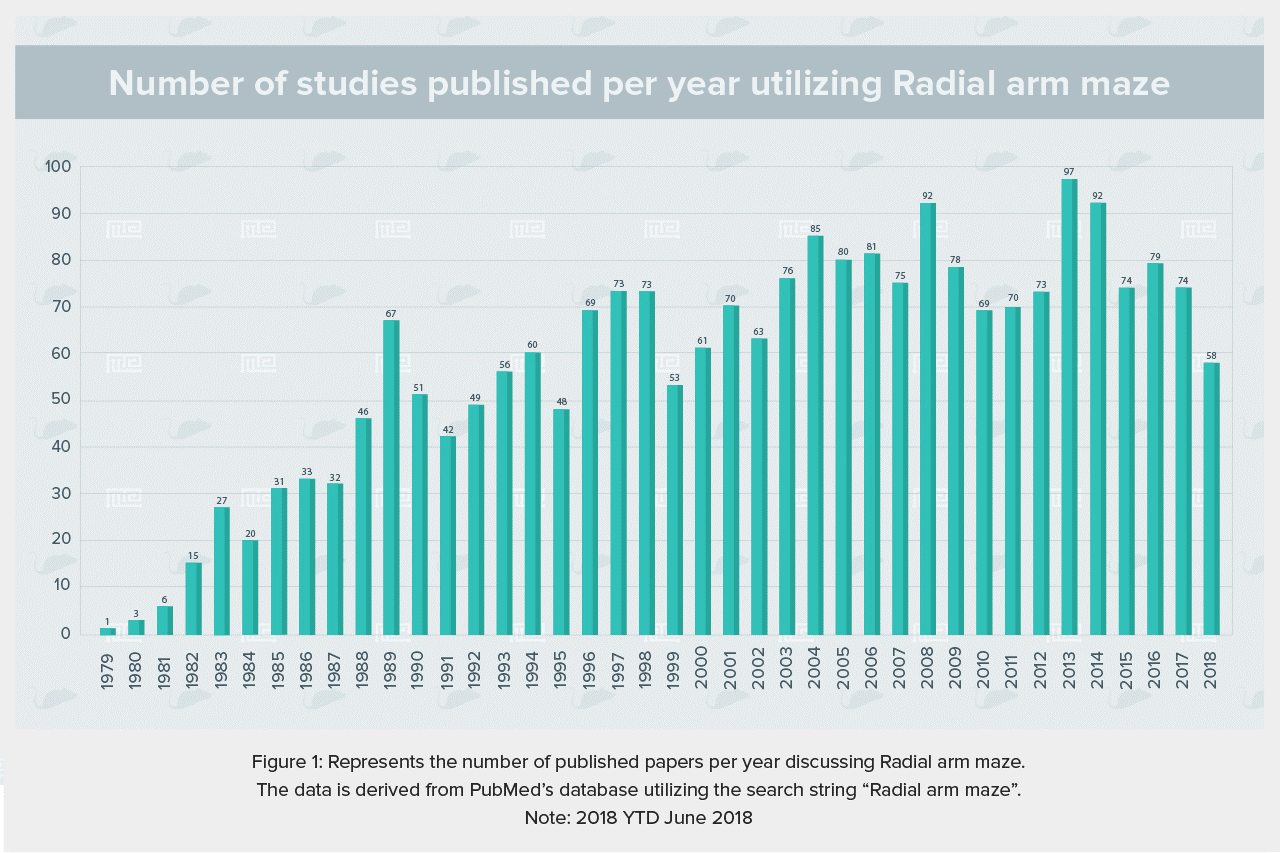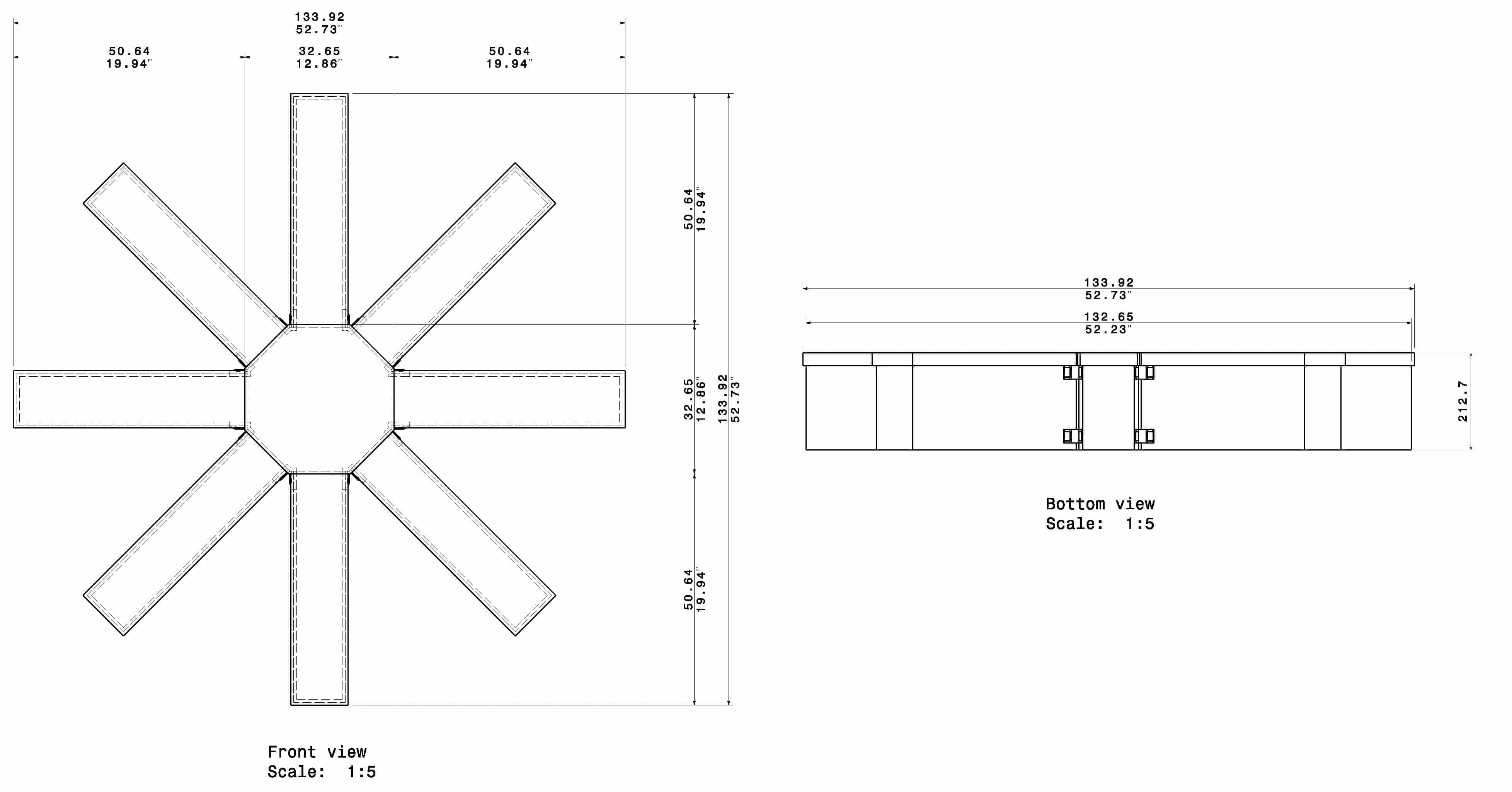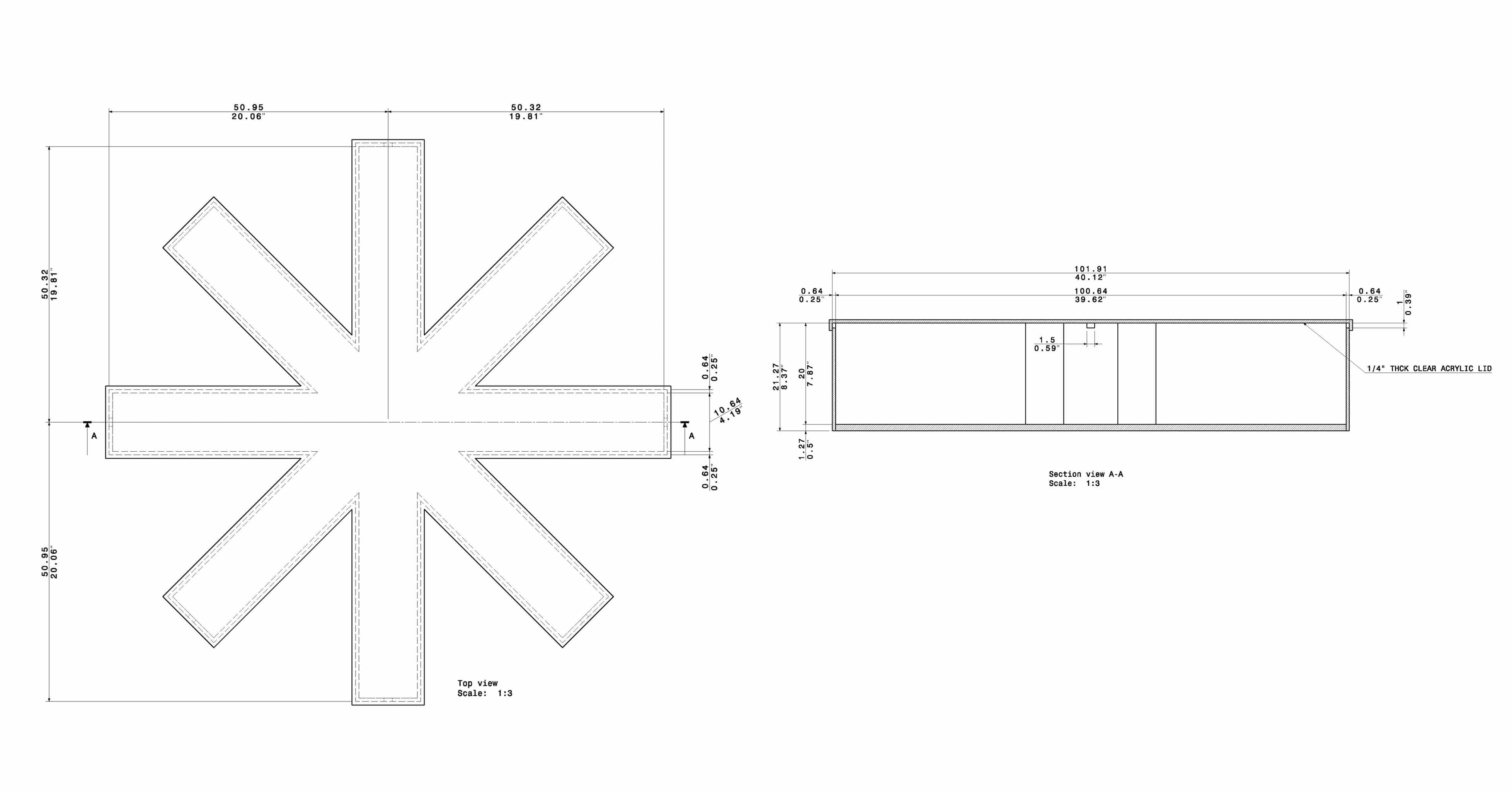Product Description
The radial arm maze (RAM) is a behavioral test used to assess spatial learning and memory in small animals such as rats and mice. The RAM consists of a central platform with several arms radiating out from it, and it is usually made of acrylic material. The arms can be baited with food or other rewards.
The test is typically conducted by placing the animal on the central platform and allowing it to explore the maze. The animal’s movements are then tracked, and different measures such as the number of arm entries, the time spent in each arm, and the number of errors made can be used to assess the animal’s spatial learning and memory abilities. The test can also be used to measure working memory by switching the location of the reward in the arms.
The radial arm maze test is a widely used and reliable method for assessing spatial learning and memory in rodents, and it has been used in a wide range of neuroscience research. It can also be used to study the effects of manipulations on spatial learning and memory. The test is considered more complex than the T-maze, as it has more options for the animal to choose from, making it harder for the animal to remember which arm had the reward.
Maze Engineers offers the Radial Arm Maze.
Modifications
Goal Box
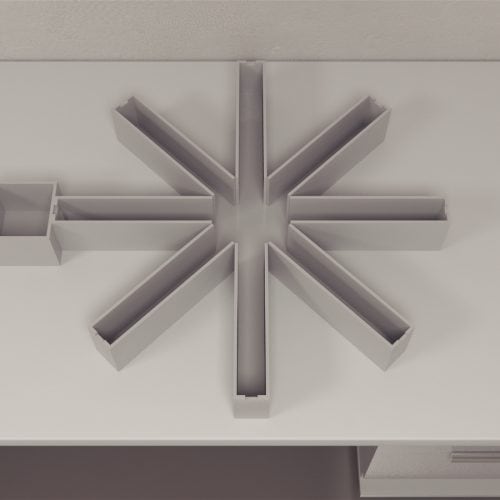
Dimensions:
Mouse - 9cm width, 9cm width, 10 cm height
Rat - 16cm width, 9cm width, 10 cm height
Light Cues
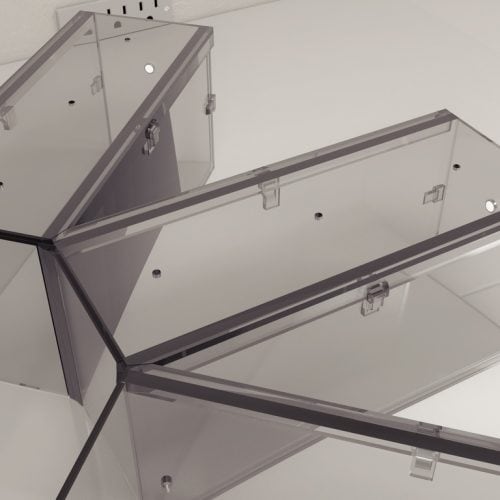
6 Arm Radial
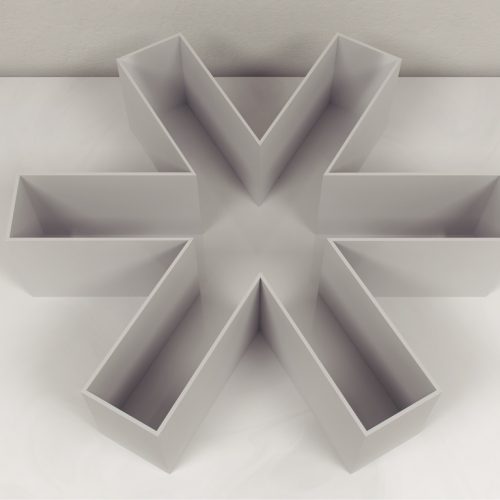
Mouse: $1690
Rat: $1790
Waterproofing
Plus Maze Insert
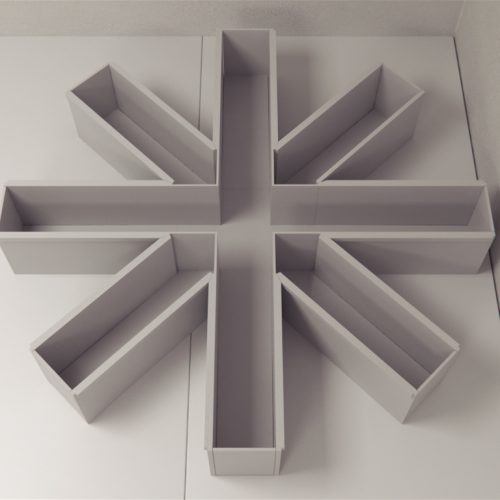
Dimensions:
Mouse - To Fit
Rat - To Fit
Y Maze Insert

T Maze Insert
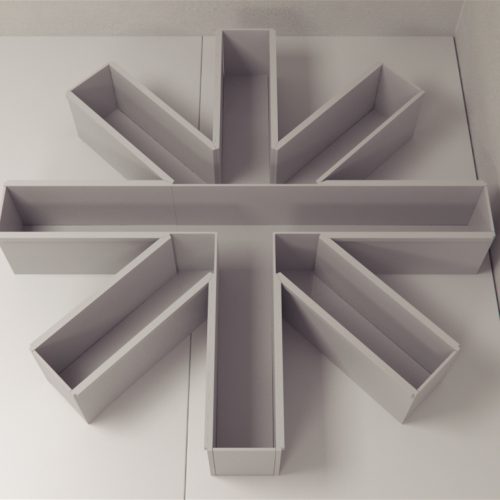
Elevated Stand
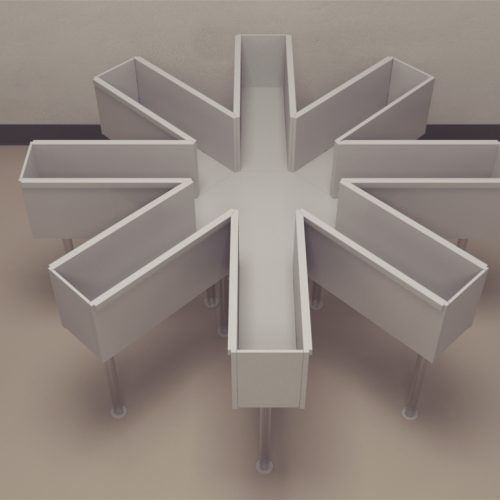
$500
Mouse
$ 1890
+ Shipping and Handling- 35cm arm length; 5cm arm width; 10cm wall height
- +$200 with Guillotine Doors
- Acrylic
- No Odors
- Easy clean with 70% Ethanol
Rat
$ 2290
+ Shipping and Handling- 50cm arm length; 10cm arm width; 20cm wall height
- +$200 with Guillotine Doors
- Acrylic
- No Odors
- Easy clean with 70% Ethanol
Food Wells
Cost $200
Doors for 8 Arms
Used for Mouse or Rat
Dimensions: Cut to fit
Cost $200
Removable Model
Used for Mouse
Dimensions: 35cm arm length; 5cm arm width; 10cm wall height
Removable Model
Used for Rat
Dimensions: 50cm arm length; 10cm arm width; 20cm wall height
Overview
The Radial Arm Maze (RAM) is one of the most widely used behavioral tasks in neuroscience. It was originally designed by Olton and Samuelson in 1976 to understand spatial learning and memory in rodents. It was observed that rodents have a remarkable ability to remember spatial locations, especially when baited with food rewards, and this ability was adapted into a behavioral task. Radial Arm Maze was developed based on the fact that finding and retrieving food quickly and efficiently served as an essential survival strategy for rodents.
The hippocampus plays a vital role in the consolidation of short-term memory to long-term memory, spatial cognition, emotional behavior, learning and regulation of hypothalamic functions. The complex structure is one of the unique brain regions that see neurogenesis continue into adult life and is vulnerable to damage by a variety of stimuli. Studies have also shown the hippocampus to be affected in a variety of neurological and psychiatric disorders(Anand & Dhikav, 2012). Therefore, behavioral tasks, such as Radial Arm Maze, assist in gaining insight into hippocampal-dependent functions and effect of hippocampus changes.
The original design of Radial Arm Maze consisted of a 34 cm wide central platform with eight equal-length arms radiating out and was initially used to observe spatial learning and memory in rodents. Recent adaptations of the maze, however, no longer limit it to the assessment of spatial learning and memory and allow concurrent investigation of working and reference memory. RAM task requires the use of hippocampal-dependent spatial reference memory, and this ability to remember the location of visited arms can be affected by the administration of certain animal models. Variations of the maze have been used in research involving birds, insects, and even humans.
Overview
Origin
The first use of Radial Arm Maze was recorded in 1976 by Olton and Samuelson who used it to demonstrate the efficiency and memory of rodents in choosing an average of more than seven different arms in the first eight choices. It has since been extensively used in behavioral neuroscience research for its ability to measure working and reference memory, its many variations, and for its minimally stressful environment.
Developments
Olton published a series of papers describing the maze and evaluation of hippocampal-dependent learning over several years (Olton and Samuelson 1976, Olton et al., 1977, Olton and Collison 1979, Olton 1987). Since these initial papers, the maze has been used to study various lesions, and even the effects of electromagnetic fields emitted from cellular phones on memory deficits (Dubreuil et al., 2003).
Recent Developments
The task apparatus has also seen various modifications over the years to include different cues (such as light cues), flexible arms (3D Radial Arm Maze), environments (Water model) and a variable number of arms, to list a few. The apparatus has also been adapted to be used with other subjects such as insects (Elizabeth et al., 2016), and humans (Mennenga et al., 2014).
An adapted human version of the Radial Arm Maze was used by Mennenga et al. to serve as a tool to connect human and rodent models of cognitive functioning. Their study evaluated human working memory and factors that contribute to the navigational ability of humans. The experiments showed that errors increased in a similar pattern as seen in a rodent model of RAM as the working memory demand increased.
The Radial Arm Maze has also seen adaptation as a computerized version wherein the subjects as tested in a virtual environment (Braun et al., 2012, Lee et al., 2014).
Apparatus and Equipment
The Radial Arm Maze’s basic construction includes a central circular platform with the arms radiating outwards. The central platform is usually of an approximate diameter of 30 cm, and the arms tend to be approximately 80 cm long with a width of 10 cm. These measurements can be varied and adjusted depending on the experimental requirement and the subject being used. The entrances of the arms usually have doors, that is either removable or guillotine styled, to limit access. The entire apparatus, in general, is transparent to allow the subject to visualize extra-maze cues, although opaque versions are also available. The apparatus is usually raised 50 cm above the floor.
Over the years the apparatus for Radial Arm Maze has been improved upon to meet different requirements of behavioral investigations. Modifications such as adding a goal box to the end of the maze arms, water models, etc. have been made to assist the needs of investigatory processes. A fully automated Radial Arm Maze is also available, which detects the location of the animal within the maze, automates opening and closing of doors within the maze, and detects the presence of the food reward in the arm chambers.
The apparatus should be well lit from above to prevent shadows to ensure the proper utilization of Radial Arm Maze. Observation of the Radial Arm Maze task can be done using tracking software such as Noldus Ethovision XTor ANY-Maze, or Glia Science’s Video Tracking software mounted above the apparatus. Live scoring is also possible.
Training Protocol
The purpose of the Radial Arm Maze is to assess spatial memory and spatial learning in animals, in control vs. disease model/intervention group, by observing their ability to navigate the arms of the maze and remember which arms they have previously entered. Typically, animals are capable of learning and remembering the location of arms with food rewards using visual cues.
This test can provide information regarding hippocampal-dependent learning, specifically spatial memory. For example, the effects on memory abilities in animal models of aging (Shukitt et al., 2004) or cognition can be tested using the Radial Arm Maze. Learning and remembering are essential to survival strategy and tends to get impacted in subjects with impaired neuro-cognitive abilities. As the aptitude to remember decreases, the subject’s task errors increase, and the subject tends to make multiple re-entries into the arms.
Several protocols exist for Radial Arm Maze depending on the experimental aim, and the data researchers are looking to obtain. The most common protocol, used in the study of hippocampal lesions or degeneration and to determine the involvement of a specific gene or protein in spatial memory, uses a fully baited version of Radial Arm Maze wherein the subject is required to visit each arm only once per trial.
Pre-Training for the Fully-Baited Radial Arm Maze
Pre-training sessions can be done across several days prior to the experiment. Subjects are placed in small groups on the maze and allowed to explore the maze for 20 minutes freely. The maze floor is scattered with food rewards to encourage the subjects to explore. On the subsequent days, food rewards are only placed at the ends of the arms. For tasks involving automated Radial Arm Maze, the subjects are also familiarized with the movements and noise of opening and closing of the automated doors.
Evaluation of Spatial Learning and Memory Using the Radial Arm Maze
Training and testing processes begin with cleaning the apparatus to minimize olfactory cues and setting up of any visual cues within the test areas. Food rewards are placed in the chambers at the end of each arm. For tasks involving automated Radial Arm Maze, doors to each of the arms are closed. The subject is brought into the room and placed on the central platform and allowed an acclimate, if necessary.
For the fully-baited training procedure, subjects are tested over the course of 10 to 20 consecutive days. Each arm chamber consists of a food reward, and the subject is expected to learn to visit each arm only once per session. The session is terminated when the subject has visited all 8 arms and has eaten the reward after 16 arm visits are made (regardless of which arms) or after a maximum of 15 minutes. For the automated Radial Arm Maze task, the subject is placed on the central platform, and the doors are opened simultaneously to allow the subject to explore.
Subject’s reference memory can also be tested by baiting some of the arms while the remaining arms remain un-baited. The session is terminated when eight minutes have passed or until all baited arms are entered. A repeated entry into a baited arm is counted as a working memory error while any entry into an un-baited arm is recorded as a reference memory error.
Modifications
Since the introduction of the Radial Arm Maze by Olton and Samuelson in the mid- 1970’s, researchers have adapted the Radial Arm Maze to meet the various requirements of the investigatory process of spatial learning and memory. While each modification allows for the collection of specific data and can help differentiate between working and reference memory, the different versions of the Radial Arm Maze all provide measures of the spatial learning, memory, and overall cognitive function.
Like the fully-baited Radial Arm Maze task, there is also a confinement/delay version of the maze. In this task when the subject enters an arm, it interrupts the infrared beam which triggers the automatic closure of the remaining doors. Once the subject returns to the central platform, the eighth door is also closed, and the subject is confined to the center for 10 seconds. After the completion of the delay, all doors are opened simultaneously, and the same procedure is repeated. (Dubreuil et al., 2003) Longer delays have also been utilized in other research, to test how long the subject can remember spatial locations (Suzuki et al., 1980, Bolhuis et al., 1986, Strijkstra et al., 1987).
Another version of Radial Arm Maze uses a setup that is not fully baited. The trial session is comprised of three phases: a training phase, a delay phase, and a test phase. For the training phase, four arms are randomly chosen and baited with food rewards while the access to the remaining four was blocked by the doors. The subject can explore the baited arms and retrieve the food rewards for approximately 5 minutes. Once the subject has retrieved all the food rewards and returned to the center, all the arms are closed, and the subject is isolated in the center platform for either 30 second or 15 minutes depending on the experimental design. After the delay, all the arm doors are simultaneously opened, and the test phase is initiated. During this phase the previously blocked, un-baited arms are baited with food rewards and the subject is expected to visit the arms that it had not visited in the training phase. The test phase begins with opening the doors and allowing the subject to retrieve the food rewards. The test is concluded when the last food reward is retrieved, or 300 seconds have expired. This version of the Radial Arm Maze has been used to study cognitive dysfunction and its relationship to depression-like symptoms. (Richter et al., 2013)
The Water Radial Arm Maze was developed to overcome the shortcomings of the dry land version of the maze. The water-based model, in contrast to the land-based model, does not require food deprivation, minimizes the influence of scent cues and utilizes the subject’s motivation for escape as an effective means to assess the working and reference learning and the memory simultaneously without the need for pre-training. For the water-based Radial Arm Maze task, the RAM apparatus is placed in a pool of water, and four arms are baited with an escape platform. The trial begins by placing the subject in the start arm, facing the wall. The subject can explore the maze for a maximum of 120 seconds or until it has reached one of the escape platforms. Subsequent trials progress by the removal of the visited escape platform. A record of all the visited arms, remaining platforms and visited platforms is maintained to correctly measure the reference memory and the working memory of the subject. (Penley et al., 2013)
The 3-D Radial Arm Maze is a modified version of the Radial Arm Maze developed by Abdel Ennaceur in 2006. Ennaceur’s 3D radial arm maze became a groundbreaking venture because of the unique design; the subjects exposed to unfamiliar open spaces without a safe alternative. The maze utilizes open spaces and spatial navigation both horizontally and vertically. Flattened, Raised, and lowered arms allow for a high degree of flexibility in various experiments.
A combination of the classic Radial Arm Maze and Barnes Maze, the Radial Arm Barnes Maze combines the advantages of both the mazes into one. The maze was first described by Paganelli’s et al. in their 2004 paper investigating influence of neural lesions on acquisition and retention of cognition in mice.
A common modification of the Radial Arm Maze is varying the arm lengths or the number of arms. The Arm Length variant RAM and the n-Arm variants RAM allow evaluating the effects of changing the lengths and number of the arms on the spatial and memory performance of the subjects.
Modifications
The data obtained from the Radial Arm Maze generally consists of following measures:
- Number of total arm entries (the animal places all four paws in an arm)
- Number of correct arm entries (the animal enters a novel arm not previously entered)
- Number of error arm entries (the animal enters an arm previously entered or enters an un-baited arm)
The time between retrieving food rewards can also be recorded as a measure of activity and willingness to explore. As the animal learns that entering a new arm results in a food reward, the number of error arm entries is expected to decrease. These values can merely be graphed and compared to a sham control group and a disease model/intervention group.
In addition to counting entries, a memory score can also be calculated.
This score describes the memory performance on a scale from -1 to 1, with a score of 1 reflecting a perfect score of only entering novel arms (Richter et al., 2013). Memory scores are likely to improve over several tests.
Graphs allow easy visualization of comparisons of the effect on spatial memory and learning between different disease or treatment groups. Control groups are usually expected to show significant improvements in their correct arm entries and memory scores while subjects in disease models of neurodegenerative disorders, for example, should show a much slower learning curve with more error entries, even after several trials. Generally, animal cohorts of 20-30 animals are sufficient to obtain p-values of <0.05 using ANOVA, chi-squared test, and post-hoc tests (Dubreuil et al., 2003, Richter et al., 2013)
Translational Research
Radial Arm Maze has also been adapted into a human model to act as a translational instrument in comparison of existing methodologies in rodent and human learning and memory research (Mennenga et al., 2014). The results of the research showed a significant correlation in error patterns seen in rodent-based models and the human-based model, as the working memory demand increased.
Genetic animal models employing delayed spatial win-shift task have shown high translational potential for the study of cognitive function (Richter et al., 2013). The model used two strains of rats: Congenitally helpless rats and rats resistant to helplessness, and tested them using Radial Arm Maze procedures used by Olton et al. and also with imposed temporal delay at some time within the sequence of arm visits. Congenitally helpless rats were shown to have impaired affective processing similar to depressed patients.
The Virtual Radial Arm Maze challenges the participant’s place learning skills, allowing assessment of their capacity to discriminate, remember and process the information as they explore the maze. The Radial Arm Maze can be easily adapted and modified to limit the use of certain strategies by the participants. Using inter-trial delays can also aid in the investigation of the memory capabilities of the participants. The absence of significant stressors and familiarization with the maze before testing allows for better observations of working and reference memory of the participants.
Strength and Limitations
Radial Arm Maze was developed to allow place learning which was, in models before it, seen as a factor that needed to be controlled. By utilizing the subject’s place learning skills, researchers can assess the capacity of the subject to discriminate, remember and process information as it explores the maze (Olton et al., 1976).
In contrast to other mazes, Radial Arm Maze does not utilize aversive stimulus to test spatial learning as seen in Morris Water Maze that requires the animals to be submerged in water and swim in order to survive by searching for an escape platform (Hodges 1996). The Radial Arm Maze also allows the use of food rewards as task motivation, rather than using escape and survival reinforcers, which intrinsically places less stress on the animals (Hodges 1996). The absence of significant stressors and familiarization with the maze prior to testing allows for better observations of working and reference memory in the animals as they perform in the maze.
The RAM assists in repeated measures of detecting steady-state reference and working memory deficits, although this does require precise analysis (Hodges 1996). Additionally, RAM can be modified to limit the use of particular strategies by limiting route choices using doors to block off arms. Doors can also be used to create novel arms that can be revealed in the subsequent trials. Automation of the apparatus is also helpful in creating triggered delays (Dubreuil et al., 2003) to test how long the subject can remember spatial locations. The Radial Arm Maze can also be modified to complement the specific needs of the study/ experiment, such as using a water environment for a task trial (Shukitt et al., 2004). In many cases, the Radial Arm Maze is used in conjunction with other mazes to study disease models or transgenic animals and gain a fuller understanding of spatial learning and memory.
As with all mazes that measure aspects of learning and memory, it is important to remember that many different processes affect the behavior of the subject in the maze. Overtraining of the subject and the subject’s preferred behavioral response can impact the test results. It should also be kept in mind that the Radial Arm Maze requires more training and is more time-consuming than other mazes used for similar measures.
Summary
- The Radial Arm Maze is extensively used to test spatial learning and memory.
- RAM task asks animals to retrieve food rewards at the end of each of eight arms without visiting an arm more than once.
- Different groups have adapted this maze in order to collect data regarding working or reference memory, and there are many modifications available, both regarding experimental protocol and data analysis.
- Animals in control groups show rapid learning as they remember the location of the arms from which they have retrieved the food reward, while in comparison, animals with neurological lesions show a much slower learning curve with lower memory scores.
Request a quote
"*" indicates required fields

